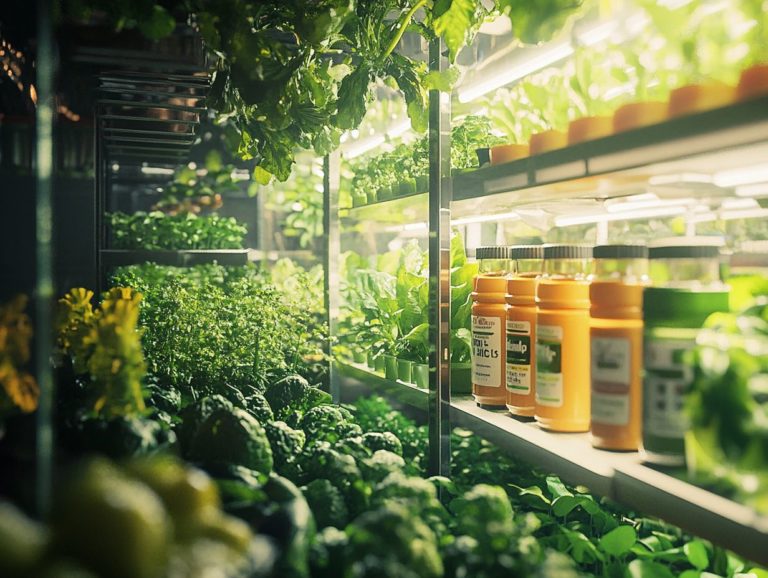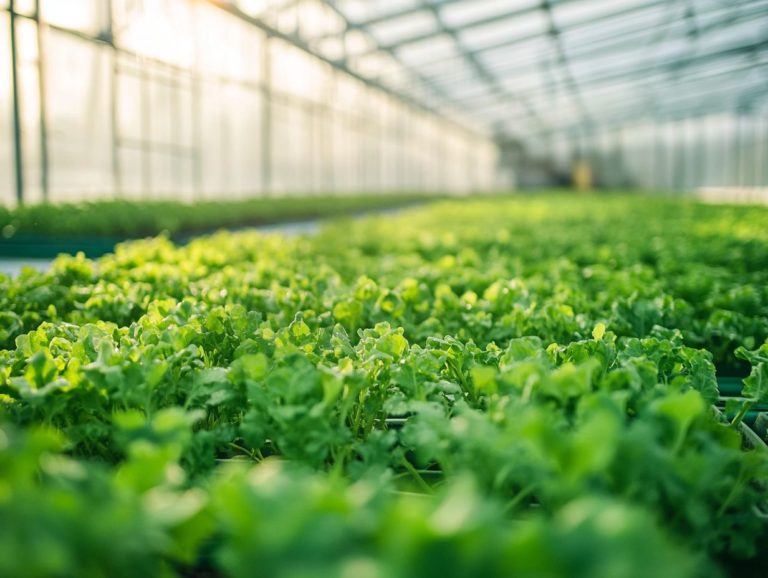Understanding the Fertilizer Label in Hydroponics
Hydroponic gardening is revolutionizing how you cultivate plants, but understanding the nuances of hydroponic fertilizer is vital for your success.
This guide will help you understand fertilizer labels, emphasizing the crucial NPK ratio and additional nutrients that promote plant vitality. You ll discover how to choose the right fertilizer tailored to your specific needs, complete with practical application and dosage guidelines.
You ll also explore organic and synthetic options, including DIY plant recipes that allow you to customize your nutrition strategy.
Jump in now to supercharge your hydroponic garden!
Contents
- Key Takeaways:
- Understanding NPK Ratio
- Interpreting the Fertilizer Label
- Choosing the Right Fertilizer for Your Plants
- Application and Dosage Guidelines
- Alternative Fertilizers for Hydroponics
- Frequently Asked Questions
- What is the purpose of the fertilizer label in hydroponics?
- What do the numbers on the fertilizer label mean?
- How do I know which fertilizer to choose for my hydroponic system?
- Do I need to dilute the fertilizer before using it in my hydroponic system?
- Can I mix different fertilizers together for my hydroponic system?
- How often should I check the fertilizer label and adjust my nutrient solution?
Key Takeaways:

- Understand the NPK ratio on fertilizer labels to provide your hydroponic plants with the necessary nutrients for growth and optimal health.
- Consider factors such as growing varieties, growth stage, and water quality when choosing the right fertilizer for your hydroponic systems.
- Follow proper application and dosage guidelines to ensure optimal growth and avoid nutrient deficiencies or toxicity in your hydroponic plants.
What is Hydroponic Fertilizer?
Hydroponic fertilizer is a specialized formulation tailored to meet the unique needs of plants grown in hydroponic systems, delivering essential nutrients in a controlled environment, all without the use of soil. These specialty plant nutrients are designed to ensure optimal nutrient availability, support plant health, and enhance yield quality. They provide a balanced mix of macronutrients, micronutrients, and trace minerals that are vital for growth and development.
Unlike traditional soil fertilizers, which rely on soil microbiomes and organic matter for nutrient release, hydroponic fertilizers offer immediate availability of nutrients directly to the plant roots. This method not only accelerates growth but also minimizes the risk of nutrient lockout and chemical impurities.
With a variety of hydroponic fertilizers on the market ranging from liquid to powdered and slow-release options it’s crucial for you to understand the composition of these products, especially the roles of nitrogen, phosphorus, and potassium.
Quality control is essential in crafting effective plant nutrient recipes. Ensuring that local hydro stores and nutrient manufacturers uphold rigorous standards for formulation consistency and are free from heavy metals ultimately results in healthier plants and more abundant harvests for you.
Understanding NPK Ratio
The NPK ratio shows the amount of nitrogen, phosphorus, and potassium in your fertilizer. These are essential nutrients for plant growth. Each of these elements has its distinct function: nitrogen fuels leaf growth, phosphorus encourages strong root systems and vibrant flowering, while potassium boosts overall plant vitality and resilience against diseases, making it crucial for addressing nutrient deficiencies.
Understanding these components is essential, as different plant varieties have tailored needs for optimal growth. For instance, if you’re nurturing leafy greens, a fertilizer with a higher nitrogen content, like 20-10-10, will help you achieve that lush foliage you desire. On the other hand, flowering plants thrive with an NPK ratio of 10-30-20 to promote abundant blooms. If you’re cultivating root vegetables, a balanced ratio such as 15-15-15 ensures that all nutrients are readily available.
Thus, selecting the appropriate fertilizer based on the NPK ratio is crucial for fostering healthy, productive plants and ensuring optimal yield quality.
Interpreting the Fertilizer Label
Understanding fertilizer labels is essential for you as a grower aiming to optimize plant growth and health. These labels contain vital information about nutrient content, including the NPK ratio, the quality and type of nutrients used in the fertilizer, and usage recommendations.
By familiarizing yourself with the components detailed on fertilizer labels, you give the power to yourself to make informed decisions that ensure nutrient quality and availability, perfectly tailored to your specific hydroponic systems.
Other Nutrients and Additives

Plants need more than just the primary nutrients indicated by the NPK ratio. They also require secondary nutrients and micronutrients for optimal health.
Key elements like calcium, magnesium, iron, and manganese play a vital role. Including these in your fertilizer can help tackle common deficiencies and boost plant growth.
Micronutrients and trace minerals support essential processes like photosynthesis and enzyme activation. They work alongside macronutrients to promote healthy growth and strengthen plants against pests and stress.
Performing a nutrient analysis helps you identify any deficiencies affecting your plants. Based on this analysis, you can use additives like chelated minerals or organic compost to enhance yields.
Choosing the Right Fertilizer for Your Plants
Choosing the right fertilizer is crucial for your plants’ health and yield quality. Consider the specific nutrient needs of different plant varieties and the associated costs.
Understanding your plants unique requirements and consulting local hydro stores can lead to better decisions. This approach improves nutrient availability and overall performance in your hydroponic systems.
Factors to Consider
Several factors influence your fertilizer selection, including costs, available nutrient sources, and the specific needs of the plants you’re cultivating. Evaluating these elements helps you find the best options within your budget.
Different plant types have unique nutrient needs and growth patterns, impacting your choices. Soil type, climate, and the presence of pests or diseases can further complicate your decisions.
Consulting with local hydro stores is valuable. Their experts can provide insights based on regional conditions and recommend tailored solutions.
Application and Dosage Guidelines
Correctly applying fertilizers is essential for your hydroponic system’s success. Specific guidelines show how much and how often to feed your plants for optimal growth.
Following these recommendations and understanding your fertilizers’ components can minimize nutrient imbalances. This ensures robust plant development.
How Much and How Often to Feed Your Plants

Determining how much and how often to feed your plants demands a delicate balance of nutrient availability, growth stage, and careful watching for any signs of nutrient deficiencies or heavy metals during cultivation. To achieve optimal growth, you should follow established application guidelines and regularly check the nutrient levels in your hydroponic systems.
This ongoing assessment is vital, especially as your plants transition from seedlings to more mature stages, each with its own specific nutrient needs. For example, young plants might crave higher nitrogen levels to fuel their growth, while flowering or fruiting stages often require a boost in phosphorus and potassium. Understanding the unique requirements of different plant species can significantly enhance your feeding schedule.
Pay close attention to changes in your plants’ appearance such as yellowing leaves or stunted growth so you can quickly adjust your fertilization tactics. This ensures that your plants thrive throughout their entire life cycle and receive quality control in their nutrient intake.
Alternative Fertilizers for Hydroponics
In your pursuit of sustainable gardening, you may explore alternative fertilizers for hydroponics, weighing the benefits of organic fertilizers against synthetic options that often deliver quicker results while considering the chemical impurities present in each.
By evaluating various nutrient formulations and fertilizer grades, you can choose the solution that best aligns with your gardening philosophy. This also promotes plant health and achieves optimal yield with quality ingredients included.
Organic vs. Synthetic Options
When considering organic and synthetic fertilizers, it s essential to scrutinize the nutrient sources and quality ingredients that each offers. Each choice has advantages and challenges, particularly regarding nutrient availability and plant health.
Organic fertilizers typically provide slow-release nutrients and improve soil health, while synthetic alternatives deliver immediate nutrients for quick plant uptake. Your choice can make a big difference!
This decision impacts not just the short-term growth and yield quality of your plants but also their long-term resilience and sustainability. While organic fertilizers enrich soil structure and promote biodiversity, synthetic fertilizers might induce rapid growth at the cost of soil quality over time.
Taking the time to analyze labels and nutrient content will help you compare the effectiveness of these products. It’s also important to consider your local soil conditions and how each fertilizer aligns with your specific crop needs for a well-informed decision.
DIY Fertilizer Recipes
Creating DIY fertilizer recipes allows you to tailor nutrient formulations specifically for your plants. Using organic matter and readily available ingredients, these homemade solutions can provide essential macronutrients and micronutrients (the nutrients plants need in larger and smaller amounts) while being cost-effective and promoting plant health, especially in hydroponic systems.
By incorporating ingredients like coffee grounds, banana peels, and eggshells, you can enrich the soil with potassium, calcium, and nitrogen. For instance, coffee grounds improve soil structure and boost microbial activity, while banana peels serve as a slow-release source of potassium, crucial for flowering plants.
Crafting personalized fertilizers allows you to address the unique needs of your plants, enhancing their overall growth and vitality. This practice fosters a sense of sustainability and deepens your connection to gardening, resulting in healthier, more robust plants that yield better produce.
Frequently Asked Questions

What is the purpose of the fertilizer label in hydroponics?
The fertilizer label provides crucial information about the nutrients in the fertilizer. This helps you choose the right one for your plants!
What do the numbers on the fertilizer label mean?
The numbers show the percentages of three vital nutrients: Nitrogen (N), Phosphorus (P), and Potassium (K). Nitrogen is listed first, followed by the others.
How do I know which fertilizer to choose for my hydroponic system?
Choose a fertilizer that meets your plants’ specific needs. A balanced ratio of NPK is ideal, and look for any extra micronutrients on the label!
Do I need to dilute the fertilizer before using it in my hydroponic system?
Yes! Always dilute according to the label before use. Undiluted fertilizer can cause problems for your plants.
Can I mix different fertilizers together for my hydroponic system?
You can mix compatible fertilizers. Just read the labels carefully to ensure the mix supports your plants’ needs.
How often should I check the fertilizer label and adjust my nutrient solution?
Check the fertilizer label regularly for adjustments. Keeping an eye on nutrient levels is key for healthy plant growth!






